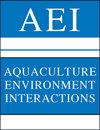Transformation of phosphorus in an experimental integrated multitrophic aquaculture system using the media filled beds method in plant cultivation
IF 2.5
2区 农林科学
Q2 FISHERIES
引用次数: 4
Abstract
The objective of this study was to trace the transformations of phosphorus in an integrated multitrophic aquaculture (IMTA) system and to determine whether the method of plant breeding influenced the dynamics of these changes. In the experiment, the media filled beds (MFB) method of plant cultivation was applied. Fish tanks were stocked with 200 common carp Cyprinus carpio, and hydroponic terraces were planted with 49 zantedeschia Zantedeschia sp. bulbs. Water samples were taken directly from the fish tanks immediately after each type of filtration (mechanical, biological and hydroponic). The basic forms of orthophosphates in the IMTA system included some H2PO4 ions but mostly HPO4. The higher supply of reactive phosphorus that occurred over time in the experiment may have contributed to a decrease in calcium ion concentration due to the formation of Ca3(PO4)2 and CaHPO4 salts, thus inactivating some of the phosphorus available to plants. Phosphorus may have also been inactivated in the sediment due to the formation of Mg3(PO4)2 and MgHPO4 salts after decreasing the concentration of calcium ions as a result of their precipitation in sediments. Mineralization of organic matter took place under aerobic conditions. Organic matter was a source of biogenic substances in the IMTA system. Experimental results showed that IMTA systems have significant potential to reduce phosphorus in aquaculture wastewater and thus provide a good environment for fish farming by improving water quality.植物栽培中介质填床法综合营养型水产养殖系统中磷的转化
本研究的目的是追踪综合多营养水产养殖(IMTA)系统中磷的转化,并确定植物育种方法是否影响这些变化的动态。本试验采用培养基充填床(MFB)植物栽培法。鱼缸内放养鲤鱼鲤鱼200条,水培梯田内种植马蹄莲球茎49根。每种过滤(机械过滤、生物过滤和水培过滤)后,直接从鱼缸中提取水样。IMTA体系中正磷酸盐的基本形态包括一些H2PO4离子,但主要是HPO4。在实验中,随着时间的推移,活性磷供应的增加可能导致钙离子浓度的降低,这是由于Ca3(PO4)2和CaHPO4盐的形成,从而使植物可利用的一些磷失活。沉积物中钙离子的沉淀降低了钙离子的浓度,形成了Mg3(PO4)2和MgHPO4盐,这也可能使沉积物中的磷失活。有机质的矿化发生在有氧条件下。有机质是IMTA系统中生物物质的主要来源。实验结果表明,IMTA系统具有显著的降低养殖废水中磷的潜力,从而通过改善水质为养鱼提供良好的养殖环境。
本文章由计算机程序翻译,如有差异,请以英文原文为准。
求助全文
约1分钟内获得全文
求助全文
来源期刊

Aquaculture Environment Interactions
FISHERIES-MARINE & FRESHWATER BIOLOGY
CiteScore
4.90
自引率
13.60%
发文量
15
审稿时长
>12 weeks
期刊介绍:
AEI presents rigorously refereed and carefully selected Research Articles, Reviews and Notes, as well as Comments/Reply Comments (for details see MEPS 228:1), Theme Sections and Opinion Pieces. For details consult the Guidelines for Authors. Papers may be concerned with interactions between aquaculture and the environment from local to ecosystem scales, at all levels of organisation and investigation. Areas covered include:
-Pollution and nutrient inputs; bio-accumulation and impacts of chemical compounds used in aquaculture.
-Effects on benthic and pelagic assemblages or processes that are related to aquaculture activities.
-Interactions of wild fauna (invertebrates, fishes, birds, mammals) with aquaculture activities; genetic impacts on wild populations.
-Parasite and pathogen interactions between farmed and wild stocks.
-Comparisons of the environmental effects of traditional and organic aquaculture.
-Introductions of alien species; escape and intentional releases (seeding) of cultured organisms into the wild.
-Effects of capture-based aquaculture (ranching).
-Interactions of aquaculture installations with biofouling organisms and consequences of biofouling control measures.
-Integrated multi-trophic aquaculture; comparisons of re-circulation and ‘open’ systems.
-Effects of climate change and environmental variability on aquaculture activities.
-Modelling of aquaculture–environment interactions; assessment of carrying capacity.
-Interactions between aquaculture and other industries (e.g. tourism, fisheries, transport).
-Policy and practice of aquaculture regulation directed towards environmental management; site selection, spatial planning, Integrated Coastal Zone Management, and eco-ethics.
 求助内容:
求助内容: 应助结果提醒方式:
应助结果提醒方式:


